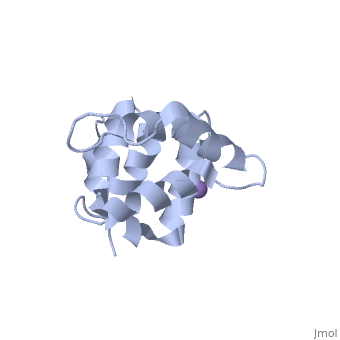2a9i: Difference between revisions
New page: left|200px<br /><applet load="2a9i" size="450" color="white" frame="true" align="right" spinBox="true" caption="2a9i, resolution 1.70Å" /> '''Molecular Structure ... |
No edit summary |
||
| Line 1: | Line 1: | ||
[[Image:2a9i.gif|left|200px]]<br /><applet load="2a9i" size=" | [[Image:2a9i.gif|left|200px]]<br /><applet load="2a9i" size="350" color="white" frame="true" align="right" spinBox="true" | ||
caption="2a9i, resolution 1.70Å" /> | caption="2a9i, resolution 1.70Å" /> | ||
'''Molecular Structure of the Interleukin-1 Receptor-Associated Kinase-4 Death Domain'''<br /> | '''Molecular Structure of the Interleukin-1 Receptor-Associated Kinase-4 Death Domain'''<br /> | ||
==Overview== | ==Overview== | ||
IL-1R-associated kinase (IRAK) 4 is an essential component of innate | IL-1R-associated kinase (IRAK) 4 is an essential component of innate immunity. IRAK-4 deficiency in mice and humans results in severe impairment of IL-1 and TLR signaling. We have solved the crystal structure for the death domain of Mus musculus IRAK-4 to 1.7 A resolution. This is the first glimpse of the structural details of a mammalian IRAK family member. The crystal structure reveals a six-helical bundle with a prominent loop, which among IRAKs and Pelle, a Drosophila homologue, is unique to IRAK-4. This highly structured loop contained between helices two and three, comprises an 11-aa stretch. Although innate immune domain recognition is thought to be very similar between Drosophila and mammals, this structural component points to a drastic difference. This structure can be used as a framework for future mutation and deletion studies and potential drug design. | ||
==About this Structure== | ==About this Structure== | ||
2A9I is a [http://en.wikipedia.org/wiki/Single_protein Single protein] structure of sequence from [http://en.wikipedia.org/wiki/Mus_musculus Mus musculus] with MN as [http://en.wikipedia.org/wiki/ligand ligand]. Active as [http://en.wikipedia.org/wiki/Non-specific_serine/threonine_protein_kinase Non-specific serine/threonine protein kinase], with EC number [http://www.brenda-enzymes.info/php/result_flat.php4?ecno=2.7.11.1 2.7.11.1] Full crystallographic information is available from [http:// | 2A9I is a [http://en.wikipedia.org/wiki/Single_protein Single protein] structure of sequence from [http://en.wikipedia.org/wiki/Mus_musculus Mus musculus] with <scene name='pdbligand=MN:'>MN</scene> as [http://en.wikipedia.org/wiki/ligand ligand]. Active as [http://en.wikipedia.org/wiki/Non-specific_serine/threonine_protein_kinase Non-specific serine/threonine protein kinase], with EC number [http://www.brenda-enzymes.info/php/result_flat.php4?ecno=2.7.11.1 2.7.11.1] Full crystallographic information is available from [http://oca.weizmann.ac.il/oca-bin/ocashort?id=2A9I OCA]. | ||
==Reference== | ==Reference== | ||
| Line 14: | Line 14: | ||
[[Category: Non-specific serine/threonine protein kinase]] | [[Category: Non-specific serine/threonine protein kinase]] | ||
[[Category: Single protein]] | [[Category: Single protein]] | ||
[[Category: Gajjar, M | [[Category: Gajjar, M M.]] | ||
[[Category: Lasker, M | [[Category: Lasker, M V.]] | ||
[[Category: Nair, S | [[Category: Nair, S K.]] | ||
[[Category: MN]] | [[Category: MN]] | ||
[[Category: hexahelical bundle]] | [[Category: hexahelical bundle]] | ||
''Page seeded by [http:// | ''Page seeded by [http://oca.weizmann.ac.il/oca OCA ] on Thu Feb 21 16:25:11 2008'' | ||
Revision as of 17:25, 21 February 2008
|
Molecular Structure of the Interleukin-1 Receptor-Associated Kinase-4 Death Domain
OverviewOverview
IL-1R-associated kinase (IRAK) 4 is an essential component of innate immunity. IRAK-4 deficiency in mice and humans results in severe impairment of IL-1 and TLR signaling. We have solved the crystal structure for the death domain of Mus musculus IRAK-4 to 1.7 A resolution. This is the first glimpse of the structural details of a mammalian IRAK family member. The crystal structure reveals a six-helical bundle with a prominent loop, which among IRAKs and Pelle, a Drosophila homologue, is unique to IRAK-4. This highly structured loop contained between helices two and three, comprises an 11-aa stretch. Although innate immune domain recognition is thought to be very similar between Drosophila and mammals, this structural component points to a drastic difference. This structure can be used as a framework for future mutation and deletion studies and potential drug design.
About this StructureAbout this Structure
2A9I is a Single protein structure of sequence from Mus musculus with as ligand. Active as Non-specific serine/threonine protein kinase, with EC number 2.7.11.1 Full crystallographic information is available from OCA.
ReferenceReference
Cutting edge: molecular structure of the IL-1R-associated kinase-4 death domain and its implications for TLR signaling., Lasker MV, Gajjar MM, Nair SK, J Immunol. 2005 Oct 1;175(7):4175-9. PMID:16177054
Page seeded by OCA on Thu Feb 21 16:25:11 2008
